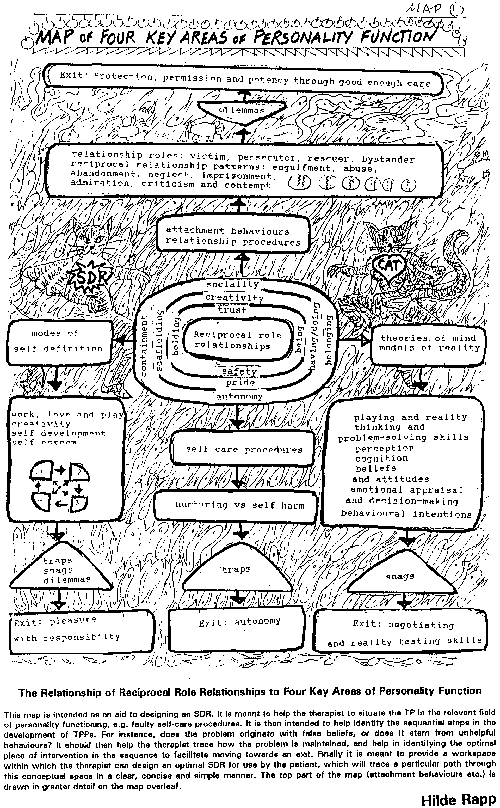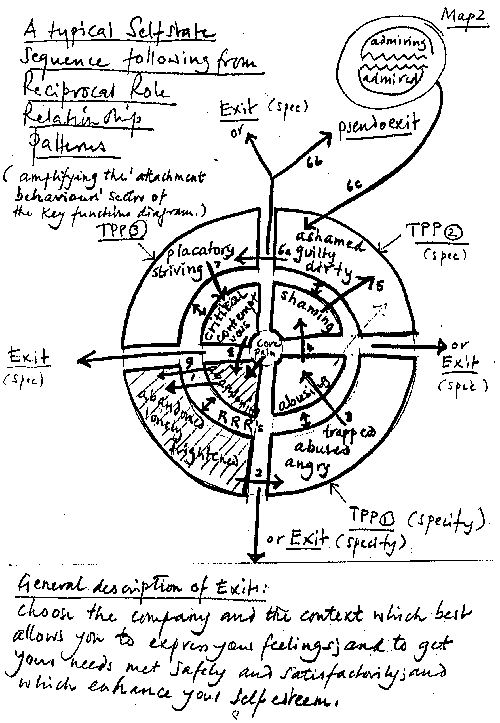A map for a road often travelled in CAT
Rapp, H., 1995. A map for a road often travelled in CAT. Reformulation, ACAT News Winter, p.x.

Fig 1. Map of four Key Areas of Personality Function
The map or diagram on the page opposite amplifies the "attachment behaviours" sector of the map on the preceding page. It illustrates a family of self state patterns which are common in people diagnosed as suffering from borderline personality disorder, especially when their history includes early experiences of neglect and sexual abuse.
When we study patterns of affect and attachment in families, together with the reciprocal role relationships between caregivers and their charges, we need to find ways of mapping the dynamics of impingement, emotional injury, emotional scarring and defences as they shift over time. There are both short-term cycles, such as TPPs which govern sequences of social or anti-social behaviour, and longer term patterns of habitual stances, which become apparent in therapy in the form of self states. TPPs flow from and reinforce such defensive or affiliative stances.
We are familiar with the tension between the twin fears of being abandoned or being engulfed which drive the behaviour of many so-called borderline patients. Often, one is more powerful than the other. The diagram opposite illustrates the case where the fear of being abandoned and neglected characterises the core pain of the patient and acts as the more powerful influence on behaviour. Obviously any of the self states could become the locus of core pain, but most frequently it will be either abandonment or engulfment. Where traumatic experiences have occurred later in life, deep shame and guilt can also be part of the core pain, as they frequently are in depression.
The inner circle represents the Inner Parentderived states of mind, and the outer circle describes the Child-derived states which have been generated in response. The paths leading to the exits represent the generative potential for spontaneous gestures of loving, acts of self-definition and creation, and socially inventive attachment behaviours, which are not environmentally derived, i.e. these are the paths between chaos and order which lead to what we might be.
A typical path through the culturally and environmentally driven behavioural repertoire of patients will put them in touch with a particular sequence of self state transitions. The assumption is that without support and recognition for their individuality, patients will stray from the path of becoming into the habitual sectors of the social formation and deformation of their selves, marked as states.
For instance: They feel bad about themselves and unlovable (core pain).
1 Withdraw from others, feel isolated and lonely and frightened.
2 Then seek company at any price. Soon feel trapped (engulfed) and abused, and then angry.
3 Behave badly and abusively.
4 Shame and blame the other person and make them feel bad and inadequate.
5 Feel bad and guilty and dirty for having behaved badly.
6 Want to do something good in order to feel better and repair some of the damage done.
7 Feel that their efforts have not been successful or been valued adequately.
8 Feel critical and contemptuous of themselves and/or of others.
9 Withdraw and lick their wounds feeling unlovable ... and so they go round the wheel of misfortune.
Exits: If their own resourcefulness and creativity meets with support, for instance through therapy, and they begin to generate new patterns of being, having, doing and belonging, which set them free in the company of others, to fluidly engage and disengage, build and undo patterns in their lives as living selves.

Fig 2. A typical Selfstate Sequence following from reciprocal role relationship patterns.
Hilde Rapp
 Petition to NHS England - The Case for Funding Training in the NHS 2021
Alert!
Petition to NHS England - The Case for Funding Training in the NHS 2021
Alert!ACAT's online payment system has been updated - click for more information

Full Reference
Rapp, H., 1995. A map for a road often travelled in CAT. Reformulation, ACAT News Winter, p.x.Search the Bibliography
Type in your search terms. If you want to search for results that match ALL of your keywords you can list them with commas between them; e.g., "borderline,adolescent", which will bring back results that have BOTH keywords mentioned in the title or author data.
Related Articles
Sequential Diagrams, Reflections and Suggested Revisions
Ryle, A., 1998. Sequential Diagrams, Reflections and Suggested Revisions. Reformulation, ACAT News Autumn, p.x.
History and Use of the SDR
Ryle, A., 2003. History and Use of the SDR. Reformulation, Autumn, pp.18-21.
Differences Between Borderline and Narcissistic Personality Disorders
Ryle, A., 2002. Differences Between Borderline and Narcissistic Personality Disorders. Reformulation, Autumn, pp.16-17.
Beyond State Shifts - Metashifts
Nehmad, A., 1997. Beyond State Shifts - Metashifts. Reformulation, ACAT News Summer, p.x.
Do we allow CAT to have a heart? Is it soft and wet? A Response.
Dunn, M., 1997. Do we allow CAT to have a heart? Is it soft and wet? A Response.. Reformulation, ACAT News Winter, p.x.
Other Articles in the Same Issue
A map for a road often travelled in CAT
Rapp, H., 1995. A map for a road often travelled in CAT. Reformulation, ACAT News Winter, p.x.
Blunt Thoughts about Sharpening the File
Morris, P., 1995. Blunt Thoughts about Sharpening the File. Reformulation, ACAT News Winter, p.x.
CAT For The Elderly
Harbour, K. and Nehmad, A., 1995. CAT For The Elderly. Reformulation, ACAT News Winter, p.x.
The Special Needs Project (CAT For Borderline Patients)
Ryle, A., 1995. The Special Needs Project (CAT For Borderline Patients). Reformulation, ACAT News Winter, p.x.
Help
This site has recently been updated to be Mobile Friendly. We are working through the pages to check everything is working properly. If you spot a problem please email support@acat.me.uk and we'll look into it. Thank you.
